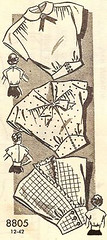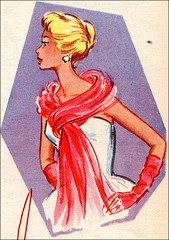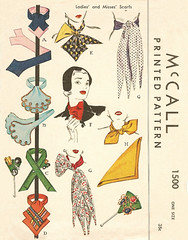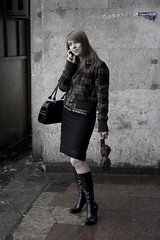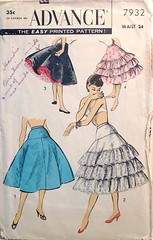I have always idealized the 1950s housewife. Everything she was and did and wore and didn’t do appealed to me since my baby brother was born and I experienced a hint of what it meant to live solely for one’s family. Hey, if the 1950s woman could look cute doing all this hard work and make life lovely for her family, what more could she ask for from a home life?
Fall from grace
Sadly, my ideals have been shattered.
The other day I read an illustrated book: Fashions of a Decade: The 1950s by Patricia Baker. One of the taglines for it was “The Living Doll.” What could that possibly mean? I quelled my curiosity and read from the beginning, learning quite a lot that I never knew about America’s fear of Communism, the Korean upheaval, and (to my great delight) young men known as “Teddy boys.” A spectacular array.
When I arrived at the “living doll” pages, however, I was immediately reminded of the movie Mona Lisa Smile. That movie was the first crack in the art deco vase of my 1950s housewife ideal. If you haven’t seen it, here’s a brief synopsis from my perspective: A teacher goes to a women’s university and learns that although the girls are extremely intelligent and capable, they see college as a quick way to meet a man, get married, and start their happy-housewife life rather than reach their intellectual potential. It’s a brilliant movie, and the costumes, hair, and makeup are very well done.
Back to the point. I didn’t go to college to find a husband, but the rest of the attitudes of the girls in the movie echoed mine very well. But the story expands on a good point: this pretty life that all these young women desire is not as pretty as it seems. Besides the inequality issues between spouses (which has undoubtedly affected people’s attitudes toward marriage ever since), one has only to look at the clothes to see where American women began to believe they had to be something completely impossible.
Who was she?
According to Baker’s book, the “living doll” appeared in all sorts ads via the new household commodity, the television set, and was amplified by myriad paper ads and catalogues. Her waist was tiny, her curves voluptuous (though always modestly covered), her makeup precise, and her lovely pin curl set pristine and tasteful. She was the epitome of the 1950s housewife.
Now I must be fair: this particular woman, appearing in so many ads and commercials, had every convenience of “modern” life. Her workload was ideally lessened by the conveniences of new home products such as refrigerators, top-loading washing machines, and microwave ovens, to name just a few. So perhaps she did have time to look as she did. But for the average housewife (although admittedly this was the heyday of America’s middle class), this was not real life. There was no way she could be everything the advertisements enjoined her to be.
This has turned into rather a rant than an exposition of the “living doll,” so let’s return to the fashionable point. How many of us would be able to achieve the nipped waist, sloped shoulder, accentuated bust, and emphasized calf and ankle that the housewives of the 1950s were expected to achieve? Perhaps if we really tried, but what about getting the housework done as well--cooking, cleaning, washing, ironing, etc.? It’s a tall order, to say the least.
It comes down to stars in the eyes of the general public. So much new technology was becoming widely available in this decade that life was supposed to be made easier at every turn. This vision could maybe, possibly be what the future looked like.
The real thing
The truth is, most women were not this idealized version of a housewife, and I can no longer pretend that it is a viable objective for me.
In reality, most women wore a loose dress, or a sweater with comfortable trousers or dungarees to do their housework. The apron with heart-shaped top and amusingly creative pockets may have been good for show, but it wasn’t practical for sopping up messes, shielding one from grease and hot oil, or dusting the furniture (because everybody knows the best way to dust furniture is with one’s apron skirt).
The future of now
At this point, although my idealized self is still canning in the kitchen with a lovely tapered hourglass figure and said apron, I can direct myself toward a more attainable goal. Whatever I do, I will do it fully. When I play housewife, I will make sure my kitchen creations engage my skills and creative capacity. When I play cocktail partier, I’ll be dolled up to the perfection of whatever body I have. When I play writer, I’ll drink coffee like a beatnik broad and get into character.
The “living doll” was an amusing vision. But now that we’ve taken her down a notch, we can rebuild that vision and those of Christian Dior’s A, S, and H lines (among others) as what they are: visions. The new goal: explore the “epitome” of whatever classic persona existed and was embodied by the few, and learn to recreate it whenever we so choose.
